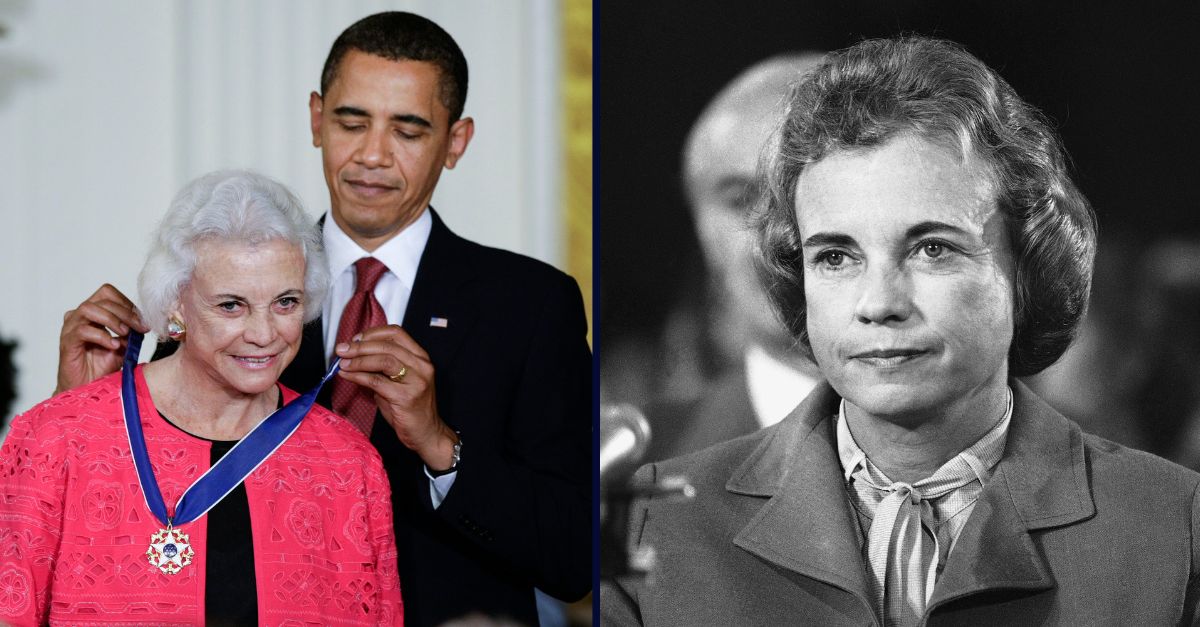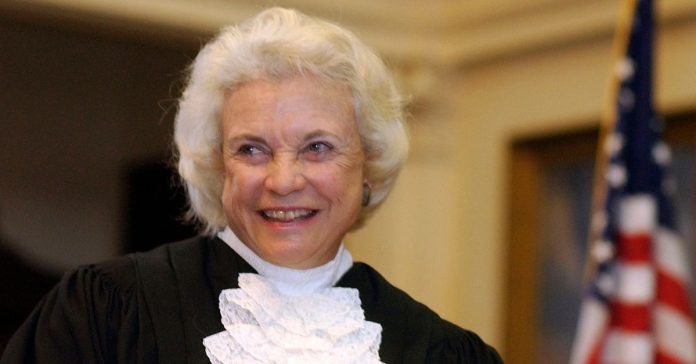
FILE — Supreme Court Justice Sandra Day O’Connor is shown before administering the oath of office to members of the Texas Supreme Court in Austin, Texas, on Jan. 6, 2003. For more than a decade, O’Connor was the only woman on the Supreme Court. And she was the first. Now the court has a record four. (AP Photo/Harry Cabluck, File )
Sandra Day O’Connor, the first woman who served on the U.S. Supreme Court and paved the way for generations of female attorneys, judges, and legal professionals to come, passed away this past Friday. O’Connor served on the Court for over two decades, from 1981 to 2006, and during her tenure, was regarded as one of the most powerful women in the world, rendering opinions in landmark cases on critical American issues such as reproductive rights, affirmative action, and the power of the U.S. government to detain enemy combatants.
While O’Connor’s passing has many in the legal community commemorating her career and legacy, it has also revived questions about the future of the Court. Since the 2020 death of Ruth Bader Ginsburg, who was the second female Supreme Court justice, much of the original makeup of the Court has shifted dramatically; while there are now more women justices than ever before — Elena Kagan, Sonia Sotomayor, Ketanji Brown Jackson, and Amy Coney Barrett — three of those women make up the entirety of the court’s reliably liberal wing. This naturally raises questions over what future Supreme Court decisions, especially those relating to women’s issues, will look like.
Even though O’Connor made a huge impact in terms of her career, she originated from humble beginnings. Born in Texas and the daughter of a rancher, O’Connor grew up on a family cattle ranch in Arizona shooting animals and working on vehicles. At the age of 16, O’Connor enrolled at Stanford University, graduating with honors and completing her law degree in 1952 at Stanford Law School, where she served on the Stanford Law Review.
Despite her academic success, no law firm in the state of California was willing to hire her due to her gender, and the only job offer she received was as a legal secretary. Even with such obstacles, O’Connor persevered, ultimately working as a deputy county attorney in San Mateo after offering to work for no salary. After getting married and having her three sons in Arizona, O’Connor served as assistant Attorney General of Arizona starting in 1965, and she later became the first woman to serve as a majority leader in the Arizona Senate. By 1974, she served as a judge in various Arizona courts, including the Arizona State Court of Appeals.
By 1981, she was appointed to the Supreme Court by then-President Ronald Reagan, making history as the first woman to ever serve on the Court. She also paved the way for other future firsts on the bench: Ginsburg was the Court’s first Jewish woman justice, Sotomayor currently serves as the first Latina justice on the high court, and Jackson is the Court’s first Black female justice.
O’Connor was cognizant even at the start as to how her performance on the Court could affect potential future opportunities for other women to serve in the same role, stating: “I didn’t want to be the last woman on the Supreme Court. If I took the job and did a lousy job, it would take a long time to get another one.” By 2006, O’Connor retired to spend more time with her family, and passed away on Dec. 1 from complications related to advanced dementia.

Left: FILE — President Barack Obama presents the 2009 Presidential Medal of Freedom to Sandra Day O’Connor, Aug. 12, 2009. O’Connor, who joined the Supreme Court in 1981 as the nation’s first female justice, has died at age 93. (AP Photo/J. Scott Applewhite, File). Right: FILE — Judge Sandra Day O’Connor, smiles as she arrives for the start of her confirmation hearings before the Senate Judiciary Committee in Capitol Hill in Washington for the post of Supreme Court Associate Justice, Sept. 9, 1981. O’Connor, who joined the Supreme Court in 1981 as the nation’s first female justice, has died at age 93. (AP Photo, File)
During her tenure at the Court, O’Connor utilized her groundbreaking position as the first female justice to achieve the same type of equality for others, stating: “It is to the U.S. Supreme Court that we all turn when we seek that which we want most from our Government: equal justice under the law.” She was behind landmark decisions such as Grutter v. Bollinger (2003), which upheld a student admissions process that considered underrepresented minority groups; Shaw v. Reno (1993), which ruled that redistricting based on race must be held to the highest standard of review under the equal protection clause of the 14th Amendment; and Planned Parenthood v. Casey (1992), which upheld the right to have an abortion as established under Roe v. Wade.
While it is clear to many that O’Connor created a lasting legacy dedicating her legal career to helping others and ensuring that such rights were afforded to all, regardless of race, gender, or any other classification, recent decisions issued by the Court have many wondering what the future holds. In June 2022, the Supreme Court overturned 50 years of precedent under Roe v. Wade, ruling that the U.S. Constitution does not confer the right to an abortion. The following year, the Court struck down affirmative action programs in college admissions.
Many in the legal community, particularly those leaning toward the more liberal or Democratic side, expressed outcry, opining that the now largely conservative makeup of the Court has played a key part in rolling back the progress made with the landmark judicial decisions O’Connor brought forward which afforded equal rights to all.
During the Donald Trump administration, three conservative justices were brought onto the Court, which initiated the start of the Court overturning major decisions regarding reproductive rights and race equality. Yet with the addition of Jackson in June 2022, some are hoping that the rights fought so hard for by O’Connor and others will not go to waste. After all, O’Connor dedicated her life and career to interpreting and upholding the law correctly so that equality became a right rather than a privilege, stating: “Society as a whole benefits immeasurably from a climate in which all persons, regardless of race or gender, may have the opportunity to earn respect, responsibility, advancement, and remuneration based on ability.”
Have a tip we should know? [email protected]

